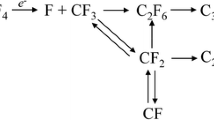Abstract
In this paper we analyze the problem of glow discharge in low pressure plasma in industrial plant, for chambers of different shapes and various working parameters, like pressure and electric potential. The model described is based upon a static approximation of the AC configuration with two electrodes and a drift diffusion approximation for the current density of positive ions and electrons. A detailed discussion of the boundary conditions imposed is given, as well as the full description of the mathematical model.
Numerical simulations were performed for a simple 1D model and two different 2D models, corresponding to two different settings of the industrial plant. The simpler case consists of a radially symmetric chamber, with one central electrode (cathode), based upon a DC generator. In this case, the steel chamber acts as the anode. The second model concerns a two dimensional horizontal cut of the most common plant configuration, with two electrodes connected to an AC generator. The case is treated in a “quasi-static” approximation. The three models show some common behaviours, particularly including the main expected features, such as dark spaces, glow regions and a wide “plasma region”. Furthermore, the three shown models show some similarities with previously published results concerning 1D and simplified 2D models, as well as with some preliminary results of the full 3D case.
Similar content being viewed by others
References
Allen JE (1976) A note on the generalized sheath criterion. J Phys D, Appl Phys 9(16):2331
Andrews JG, Stangeby PG (1970) Generalization of the sheath criterion in an anisotropic plasma. J Phys A, Gen Phys 3(5):L39
Barnes MS, Cotler TJ, Elta ME (1987) Large-signal time-domain modeling of low-pressure rf glow discharges. J Appl Phys 61(1):81–89
Boeuf J-P (1987) Numerical model of rf glow discharges. Phys Rev A 36(6):2782–2792
Boeuf JP (1988) A two-dimensional model of dc glow discharges. J Appl Phys 63:1342
Boeuf JP, Pitchford LC (1995) Two-dimensional model of capacitively coupled rf discharge and comparisons with experiments in the gaseous electronics conference reference reactor. Phys Rev E 51(2):1376–1390
Bohm D (1949) In: Guthrie A, Wakerling RK (eds) The characteristics of electrical discharges in magnetic fields. McGraw-Hill, New York, p 77
Class WH Basics of plasmas. Internal notes by Materials Research Corporation
Comsol AB COMSOL multiphysics user’s guide. Version: September, 2005
Deuflhard P (1974) A modified Newton method for the solution of ill-conditioned systems of nonlinear equations with application to multiple shooting. Numer Math 22(4):289–315
Fiala A, Pitchford LC, Boeuf JP (1994) Two-dimensional, hybrid model of low-pressure glow discharges. Phys Rev E 49(6):5607–5622
Franklin RN, Ockendon JR (1970) Asymptotic matching of plasma and sheath in an active low pressure discharge. J Plasma Phys 4(02):371–385
Godyak V, Sternberg N (2002) On the consistency of the collisionless sheath model. Phys Plasmas 9:4427
Gogolides E, Nicolai J-P, Sawin HH (1989) Comparison of experimental measurements and model predictions for radio-frequency ar and sf[sub 6] discharges. J Vac Sci Technol A, Vac Surf Films 7(3):1001–1006
Graves DB (1987) Fluid model simulations of a 13.56-MHz rf discharge: Time and space dependence of rates of electron impact excitation. J Appl Phys 62:88
Graves DB, Jensen KF (1986) A continuum model of DC and RF discharges. IEEE Trans Plasma Sci 14(2):78–91
Guo S, van Ooij WJ (1998) Kinetics of DC discharge plasma polymerization of hexamethyldisiloxane and pyrrole. Plasmas Polym 3(1):1–21
Hagelaar GJM, de Hoog FJ, Kroesen GMW (2000) Boundary conditions in fluid models of gas discharges. Phys Rev E 62(1):1452–1454
Hegemann D, Schutz U, Fischer A (2005) Macroscopic plasma-chemical approach to plasma polymerization of HMDSO and CH4. Surf Coat Technol 20:458–462
Meyyappan M, Kreskovsky JP (1990) Glow discharge simulation through solutions to the moments of the Boltzmann transport equation. J Appl Phys 68:1506
Mojab CJ (1981) Glow discharge processes, by Brian Chapman. J Vac Sci Technol 19(3):812–812
Muta H, Koga M, Itagaki N, Kawai Y (2002) Numerical investigation of a low-electron-temperature ECR plasma in Ar/N2 mixtures. Surf Coat Technol 171(1–3):157–161
Passchier JDP, Goedheer WJ (1993) A two-dimensional fluid model for an argon rf discharge. J Appl Phys 74:3744
Posin DQ (1936) The Townsend coefficients and spark discharge. Phys Rev 50(7):650–658
Richards AD, Thompson BE, Sawin HH (1987) Continuum modeling of argon radio frequency glow discharges. Appl Phys Lett 50(9):492–494
Riemann KU (1991) The Bohm criterion and sheath formation. J Phys D, Appl Phys 24:493–518
Riemann KU (1997) The influence of collisions on the plasma sheath transition. Phys Plasmas 4:4158
Roy S, Pandey BP, Poggie J, Gaitonde DV (2003) Modeling low pressure collisional plasma sheath with space-charge effect. Phys Plasmas 10:2578
Sanders FH (1932) The value of the Townsend coefficient for ionization by collision at large plate distances and near atmospheric pressure. Phys Rev 41(5):667–677
Sanders FH (1933) Measurement of the Townsend coefficients for ionization by collision. Phys Rev 44(12):1020–1024
Scheuer JT, Emmert GA (1988) A collisional model of the plasma presheath. Phys Fluids 31(6):1748–1756
Sheridan TE, Goree J (1991) Collisional plasma sheath model. Phys Fluids B, Plasma Phys 3:2796
Surendra M, Graves DB, Jellum GM (1990) Self-consistent model of a direct-current glow discharge: Treatment of fast electrons. Phys Rev A 41(2):1112–1125
Tonks L, Langmuir I (1929) A general theory of the plasma of an arc. Phys Rev 34(6):876–922
Townsend J (1915) Electricity in gases. Clarendon, Oxford
Valentini H-B (1996) Bohm criterion for the collisional sheath. Phys Plasmas 3(4):1459–1461
Valentini H-B (2000) Sheath formation in low-pressure discharges. Plasma Sources Sci Technol 9(4):574
Wang SB, Wendt AE (1999) Sheath thickness evaluation for collisionless or weakly collisional bounded plasmas. IEEE Trans Plasma Sci 27(5):1358–1365
Ward AL (2004) Calculations of cathode-fall characteristics. J Appl Phys 33:2789
Zawaideh E, Najmabadi F, Conn RW (1986) Generalized fluid equations for parallel transport in collisional to weakly collisional plasmas. Phys Fluids 29(2):463–474
Author information
Authors and Affiliations
Corresponding author
Rights and permissions
About this article
Cite this article
Speranza, A., Barletti, L., Meacci, L. et al. Glow discharge in low pressure plasma PVD: mathematical model and numerical simulations. Meccanica 46, 681–697 (2011). https://doi.org/10.1007/s11012-010-9330-z
Received:
Accepted:
Published:
Issue Date:
DOI: https://doi.org/10.1007/s11012-010-9330-z



